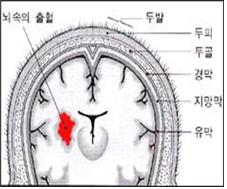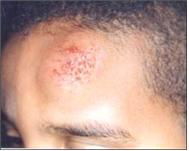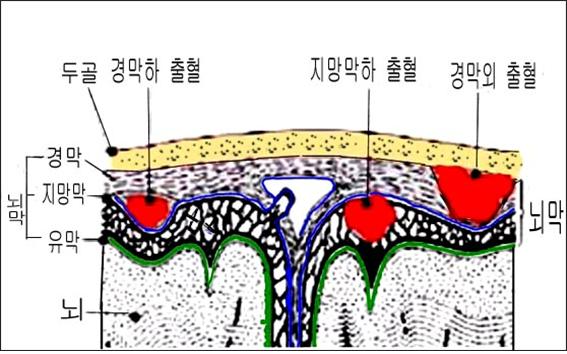두부 외상 Head trauma
두부 외상의 개요와 뇌의 기능
-
뇌를 둘러싸고 있는 뼈를 두개골, 두골 또는 머리뼈라고 하고, 두개골을 둘러싸고 있는 피부를 두피라고 한다.
-
뇌는
-
대뇌,
-
간뇌,
-
뇌간,
-
소뇌로 이루어졌다.
-
-
뇌는 인간 기본 기능–호흡기능, 심장 기능과 혈류기능, 위장 기능, 근육 골격 기능, 그외 신체 각 계통의 움직임 등을 조절하고 생각, 감정, 감각, 기억, 언어 등을 조절한다.
-
뇌 손상이 생기면 손상의 중증도에 따라 이런 기능 장애가 올 수 있다.
-
각 계통의 기능 장애는 뇌 손상이 생긴 부분이나 손상의 중증도에 따라 일시적으로도 생길 수도 있고 장기적으로, 때로는 영구적으로 생길 수 있고, 때로는 회복되지 않을 수 있다.
-
두부 외상을 입었을 때
-
두피 좌상이나
-
두피 절상,
-
두개골 골절,
-
뇌진탕,
-
두개강 내 출혈,
-
뇌 부종
-
그 외 여러 가지의 손상이 함께 생길 수 있다.
-
-
두부 외상을 입었을 때도 두피나 두개골에는 아무 이상이 없지만 두개강 내에 있는 대뇌 및 또는 소뇌에 손상이 생길 수 있다.

그림1-161. 뇌 속 출혈
Copyright ⓒ 2013 John Sangwon Lee, MD., FAAP
-
두부가 어디에 부딪히면 부딪힌 쪽 두부에 있는 뇌 부분에 손상이 생길 수 있지만 부딪힌 쪽 뇌 부분에는 아무 손상이 없고 부딪힌 두부 쪽 정 반대 쪽에 있는 뇌 부분이 손상될 수도 있다. 이런 현상을 역하격 손상이라고 한다.
-
두부가 어디에 부딪히면 때로는 뇌간 손상이 생길 수 있다.
그림1-160. 경막외 출혈, 경막하 출혈, 지망막하 출혈(지주막하 출혈)
Copyright ⓒ 2013 John Sangwon Lee, MD., FAAP
두부 외상의 종류
① 두개골 골절,
② 두혈종,
③ 두개강 내 출혈,
④ 경한 두부 외상과 심한 두부 외상으로
분류할 수 있다.
경한 두부 외상
① 두피 좌상
② 두피 절상
③ 두피 혈종
심한 두부 외상
① 뇌진탕
② 뇌좌상
③ 두개골 골절
④ 두개강 내 출혈
⑤ 뇌 절상
경한 두부 외상

사진1-163. 왼쪽 두피 좌상
Copyright ⓒ 2013 John Sangwon Lee, MD., FAAP
-
높은 곳에서 떨어지든지, 넘어지든지, 또는 머리를 어디에 세게 부딪칠 때 두피 좌상이나 두피 절상 등이 생길 수 있다.
-
이와 같이 머리의 피부(두피)에만 외상이 생기고 의식은 잃지 않고, 부딪친 두피가 조금 아플 수 있지만 구토하지 않고, 그 밖에 다른 증상이 거의 없으면 경한 두부 외상이라 한다.
-
경한 두부 외상을 입고 머리가 아프다고 하면 일단 의사에게 문의하여 적절한 치료를 받아야 한다.
-
대부분의 경한 두부 외상은 의사의 지시에 따라 집에서 관찰적 치료를 하는 것이 보통이다.
두부 외상을 입은 후 처음 경한 두부 외상으로 추정했지만 다음과 같은 경우 의사에게 응급으로 도움을 받아야 한다.
-
얼마 후 구토·현기증·두통 등의 증상 징후가 생길 때,
-
두부 외상을 입은 후 계속 잠만 자려고 할 때,
-
맥박이나 호흡이 비정상적으로 느리거나 빠를 때,
-
얼굴이 창백하거나 보챌 때는
-
병원 응급실이나 단골 의사의 지시에 따라 응급으로 진단치료를 받아야 한다.
Head trauma 두부 외상
Overview of head trauma and brain function
• The bones surrounding the brain are called the skull, skull, or skull, and the skin surrounding the skull is called the scalp.
• The brain
o cerebrum,
o brain,
o brain stem,
o Consists of the cerebellum.
• The brain controls basic human functions-breathing function, heart function and blood flow function, gastrointestinal function, musculoskeletal function, and other movements of various body systems, and controls thoughts, emotions, sensations, memory, and language.
• When brain damage occurs, this dysfunction can occur, depending on the severity of the injury.
• The dysfunction of each system may occur temporarily, may occur in the long term, sometimes permanently, and sometimes may not recover, depending on the area of the brain injury or the severity of the injury.
• In case of head trauma o Scalp strain or o scalp lift, o skull fracture, o concussion, o bleeding in the cranial cavity,
o swelling of the brain
o Other damage may occur together.
• There is no abnormality in the scalp or skull even when a head trauma occurs, but damage to the cerebrum and/or cerebellum within the cranial cavity may occur.

Figure 1-161. Bleeding in the brain Copyright ⓒ 2013 John Sangwon Lee, MD., FAAP
• If the head hits somewhere, the part of the brain on the side of the bumped head may be damaged, but there is no damage to the part of the brain on the side of the bump, and the part of the brain on the opposite side of the bumped head may be damaged. This phenomenon is called reverse damage.
• A bump on the head can sometimes cause brainstem damage.

Figure 1-160. Epidural hemorrhage, subdural hemorrhage, subretinal hemorrhage (subarachnoid hemorrhage) Copyright ⓒ 2013 John Sangwon Lee, MD., FAAP
Types of head trauma
① skull fracture,
② cephalohematoma,
③ intracranial bleeding,
④ Mild head trauma and severe head trauma Can be classified.
Mild head trauma
① Scalp seat
② Scalp lift
③ scalp hematoma Severe head trauma
① Concussion
② Brain contusion
③ skull fracture
④ bleeding in the cranial cavity
⑤ Brain cut Mild head trauma

Photo 1-163. Left scalp upper left Copyright ⓒ 2013 John Sangwon Lee, MD., FAAP
• Scalp strains or scalp cuts may occur when falling from a high place, falling over, or hitting your head hard.
• In this way, trauma occurs only on the skin (scalp) of the head, without losing consciousness, and the scalp hit may be a little painful, but does not vomit, and when there are few other symptoms, it is called a mild head trauma.
• If you have a mild head trauma and your head hurts, you should first ask your doctor for appropriate treatment.
• Most minor head traumas are usually treated at home as directed by a doctor. It was presumed to be the first minor head trauma after head trauma, but you should seek emergency help from a doctor in the following cases:
• When symptoms such as vomiting, dizziness, or headache develop after some time,
• When trying to sleep only after suffering head trauma,
• When your pulse or breathing is abnormally slow or fast,
• When the face is pale or plump
• You must receive diagnostic treatment as an emergency in the hospital emergency room or as directed by your regular doctor.
출처와 참조 문헌 Sources and references
- NelsonTextbook of Pediatrics 22ND Ed
- The Harriet Lane Handbook 22ND Ed
- Growth and development of the children
- Red Book 32nd Ed 2021-2024
- Neonatal Resuscitation, American Academy Pediatrics
- www.drleepediatrics.com제12권. 소아청소년 신경 정신 질환, 행동 수면 문제
- www.drleepediatrics.com제7권 소아청소년 감염병
- Red book 29th-31st edition 2021
- Nelson Text Book of Pediatrics 19th — 21st Edition
- The Johns Hopkins Hospital, The Harriet Lane Handbook, 22nd edition
-
두부 외상 (Head trauma)
-
두피 좌상 (Scalp contusion)
-
두피 절상 (Scalp laceration )
-
두혈종 (Cephalohematoma)
-
심한 두부 외상 (Severe head trauma)
-
뇌 진탕 (Cerebral concussion)
-
뇌 좌상 (Brain contusion)
-
두개골 골절 (Skull fractures)
-
두개강 내 출혈 (Intracranial bleeding )
-
뇌 절상 (Brain laceration)
-
두개골 골절 (Skull fractures)
-
산류 (Caput succedaneum)
-
신생아 두혈종 (Cephalohematoma of newborn infants)
-
Childhood Emergencies in the Office, Hospital and Community, American Academy of Pediatrics
-
Emergency Medical Service for Children, By Ross Lab. May 1989. p.10
-
Emergency care, Harvey grant, and Robert Murray
-
Emergency Care Transportation of Sick and Injured American Academy of Orthopaedic Surgeons
-
Emergency Pediatrics A Guide to Ambulatory Care, Roger M. Barkin, Peter Rosen
-
Immediate care of the acutely ill and injured, Hugh E. Stephenson, Jr
-
The Critically Ill Child, Diagnosis and Management, Edited by Clement A. Smith
-
Emergency Medical Services for Children: The Role of the Primary Care Provider, America Academy of Pediatrics
-
Quick Reference To Pediatric Emergencies, Delmer J. Pascoe, M.D., Moses Grossman, M.D. with 26 contributors
-
Manual of Emergency Care
-
응급환자관리 정담미디어
-
소아가정간호백과-부모도 반의사가 되어야 한다, 이상원
-
Neonatal Resuscitation American heart Association
-
Neonatology Jeffrey J.Pomerance, C. Joan Richardson
-
Pediatric Resuscitation Pediatric Clinics of North America, Stephen M. Schexnayder, M.D.
-
Pediatric Critical Care, Pediatric Clinics of North America, James P. Orlowski, M.D.
Preparation for Birth. Beverly Savage and Dianna Smith
-
Infectious disease of children, Saul Krugman, Samuel L Katz, Ann A. Gershon, Catherine Wilfert
-
The Harriet Lane Handbook 19th Edition
-
소아과학 대한교과서
-
제1권 소아청소년 응급의료 참조문헌과 출처
-
Other
Copyright ⓒ 2015 John Sangwon Lee, MD., FAAP
“부모도 반의사가 되어야 한다”-내용은 여러분들의 의사로부터 얻은 정보와 진료를 대신할 수 없습니다.
“The information contained in this publication should not be used as a substitute for the medical care and advice of your doctor. There may be variations in treatment that your doctor may recommend based on individual facts and circumstances. “Parental education is the best medicine.”